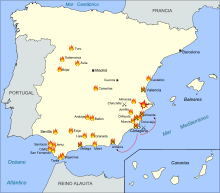Canton of Cartagena
Canton of Cartagena Cantón de Cartagena (Spanish) | |||||||||
|---|---|---|---|---|---|---|---|---|---|
| 1873–1874 | |||||||||
|
Flag | |||||||||
| Capital | Cartagena | ||||||||
| Government | Commune (junta) | ||||||||
| Historical era | Sexenio Democrático | ||||||||
• Established | July 12, 1873 | ||||||||
• Disestablished | January 12, 1874 | ||||||||
| |||||||||
| Today part of | Spain | ||||||||
The Canton of Cartagena (
History

Background
With King
In southern Spain, federalist sentiment was strong and tied to the concept of autonomous cantons or communes. At the time,
During the first chaotic months of the Spanish Republic following the 1873 election, the FRE-AIT sensed an opportunity to organize a general strike in
Establishment
With the success of Francesc Pi's Federal Democratic Republican Party in the 1873 election, many Spaniards saw the decentralization of Spain into federated cantons as an inevitable outcome. President Pi's government believed that decentralization would need to be top-down in order to legally establish the autonomy of individual cantons. By July 1873, tensions were growing in southern Spain with more radical federalists (known as "intransigents") believing that the election's results had provided a mandate to establish autonomous cantons from the bottom-up.[1]: 268-269

Cartagena, on the southern
: 165–166A provisional junta was quickly established in Cartagena City Hall, led by Manuel Cárceles Sabater.[6]: 296 Antonio Gálvez Arce was proclaimed general of the canton's military forces and was able to persuade the naval garrison situated in the port to side with the cantonal rebels, thus providing the junta with its own fleet.[1]: 261-262 The Committee of Public Health sent Juan Contreras y Román from Madrid to help organize the rebel troops in Cartagena. Barcia would soon follow Contreras to Cartagena after the intransigents were purged from Madrid. Originally called the Canton of Murcia, the junta hoped that the entire Region of Murcia would join the autonomous canton.[6]: 296 Though inspired by the Petroleum Revolution in Alcoy, the FRE-AIT did not take part in the organization of the canton.[3]
Expansion
Within days of the insurrection in Cartagena, uprisings spread throughout Murcia and southern Spain leading to the larger Cantonal rebellion. Many communities in Murcia declared their allegiance with the Murcian Canton while other communities declared their own autonomous cantons. President Francesc Pi, sympathetic to the cantonal cause, attempted to negotiate with the provisional junta in Cartagena. Unsuccessful, Pi was forced to resign on July 18 and was replaced by the moderate Nicolás Salmerón y Alonso.[1]: 252 Salmerón, unlike Pi, made it known he was willing to suppress rebellious cantons with force if necessary.[1]: 256
Cartagena was quick to mobilize both its navy and army in spreading the cantonal movement. Galvez, in command of the frigate
Defeat

After the Battle of Chinchilla, Salmerón was able to re-establish republican control in much of southern Spain under the command of General
Castelar's first attempt to besiege Cartagena by sea was thwarted on October 16 during the
The First Spanish Republic based in Madrid was unable to maintain its loose grip on control and on January 3, 1874, the federal government was overthrown in a coup led by Manuel Pavía establishing a military dictatorship.[1]: 326 Any hope in Cartagena for recognition of the cantonal system was lost after Pavia's coup. On January 7, an explosion at an artillery storehouse in Cartagena killed over 300, mostly civilians. Finally, on January 12, the City surrendered and the remaining cantonal leaders with approximately 500 refugees fled by frigate to Algeria.[8]: 419-422 The next day, government troops entered Cartagena.[1]: 299
Aftermath
With most intransigents either killed or escaped, Cartagena was easily pacified. The city was largely devastated after the siege and it is estimated that approximately 70% of the city's buildings were destroyed.
Not only did the radical cantonal movement collapse with the fall of Cartagena, so too did hope for the stability of republicanism in Spain. Later that same year, the Bourbon monarchy was restored. The Second Spanish Republic was established 57 years later and would also precede a period of radicalism in Spain. Anarcho-syndicalism in the spirit of the cantonal movement would be revived by the Confederación Nacional del Trabajo (CNT) in Catalonia in the 1930s.[11]
See also
References
- ^ a b c d e f g h i j k Brandt, Joseph A. (1933). Toward the New Spain. Chicago, IL: The University of Chicago Press.
- ISBN 9788484320586.
- ^ a b c Woodcock, George (1962). Anarchism: A History of Libertarian Ideas and Movements. Cleveland, OH: The World Publishing Company.
- ^ Engels, Friedrich (1873). "The Bakuninists at Work".
- ^ ISBN 9788474928969.
- ^ a b Pérez Crespo, Antonio (1994). "Incidencia en la región murciana del fenómeno cantonalista". Anales de Historia Contemporánea (in Spanish). 10. Retrieved 30 December 2020.
- ISBN 9788400054021.
- ^ ISBN 9788487408205.
- ISBN 978-84-7564-021-1.
- ^ Egea, Manu (18 January 2016). "Barras y estrellas para Cartagena". El País (in Spanish). Retrieved 21 May 2021.
- ISBN 9780914156147.

